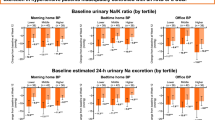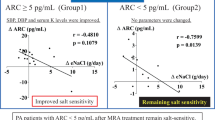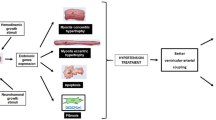Abstract
The aim of this study was to evaluate whether salt-sensitivity in essential hypertension produces a significant comparative difference in diastolic function and ventricular mass when compared with sodium-resistance. Recent epidemiological data have demonstrated a positive correlation between sodium intake and arterial pressure. Furthermore, a positive correlation has been detected between sodium intake and left ventricular hypertrophy (LVH) independently of arterial pressure. Thirty-one patients who had never been treated before for uncomplicated hypertension were studied. Each subject received a 30 mmol/per day sodium diet for 14 days, supplemented with a further 190 mmol of sodium in the first study week (220 mmol for the first 7 days and 30 mmol for the second 7 days). Throughout the study compliance was assessed by measuring daily urinary sodium excretion. Sodium sensitivity of blood pressure was defined as the difference (5% or more) between blood pressure at the end of the low and high sodium intake periods. On this basis 16 patients were defined as salt-sensitive (SS) and 15 patients as salt-resistant (SR). The two groups were homogeneous for age, sex and race. Baseline mean arterial pressure (MAP) was comparable between SS (108 ± 1.8 mm Hg) and SR (107 ± 2.1 mm Hg, P = NS). Each patient was submitted to M-MODE and two-dimensional echocardiogram studies in order to estimate left ventricular mass using the Penn conventional formula and parameters of left ventricular diastolic function. The left ventricular mass measurement showed higher values in the SS group although this did not reach statistical significance (118.4 ± 4.4 vs 112.0 ± 4.2 gr/mq, P = NS). Both interventricular septal and posterior wall thickness did not demonstrate significant differences between the two groups. The salt-sensitive group showed impaired left ventricular diastolic function; in particular, the first diastolic peak representing the early maximum of diastolic filling velocity (E) was lower in SS subjects than in SR subjects (71.6 ± 2.9 vs83.1 ± 3.3 cm/sec, P < 0.02). no significant difference was detected in the second peak representing the atrial maximum of filling velocity (a) (69.0 ± 2.3 vs 66.0 ± 2.0 cm/sec, P = NS). As a consequence the E/A ratio was significantly different (0.73 ± 0.2 in the SR vs 1.2 ± 0.04 in the SS group, P < 0.05). moreover, the peak e integral was lower in ss than in sr subjects (8.7 ± 0.6 vs11.2 ± 0.5 cm, P < 0.005; no difference for the peak a integral (6.0 ± 0.3 vs 5.7 ± 0.4 cm, P = NS). The E peak deceleration time was significantly reduced in the SS group (400.3 ± 13.5 vs 500.9 ± 12.8 cm/sec, P < 0.001). no significant difference was found for the isovolumetric relaxation time (ivrt) (95.7 ± 4.3 vs 92.2 ± 4.0, P = NS). Our data show an impaired diastolic function expressed by a reduced early diastolic filling velocity (peak E) and a significantly abnormal E/A ratio in SS in comparison with SR subjects. Therefore abnormalities in diastolic function are detectable earlier in SS hypertensive subjects than in SR irrespective of actual MAP.
This is a preview of subscription content, access via your institution
Access options
Subscribe to this journal
Receive 12 digital issues and online access to articles
$119.00 per year
only $9.92 per issue
Buy this article
- Purchase on Springer Link
- Instant access to full article PDF
Prices may be subject to local taxes which are calculated during checkout
Similar content being viewed by others
Author information
Authors and Affiliations
Rights and permissions
About this article
Cite this article
Musiari, L., Ceriati, R., Taliani, U. et al. Early abnormalities in left ventricular diastolic function of sodium-sensitive hypertensive patients. J Hum Hypertens 13, 711–716 (1999). https://doi.org/10.1038/sj.jhh.1000893
Received:
Revised:
Accepted:
Published:
Issue Date:
DOI: https://doi.org/10.1038/sj.jhh.1000893
Keywords
This article is cited by
-
Gender Differences in Diastolic Function Among Youth
Pediatric Cardiology (2008)
-
Tortuosity of coronary arteries: an indicator for impaired left ventricular relaxation?
The International Journal of Cardiovascular Imaging (2007)
-
The role of sodium in hypertension is more complex than simply elevating arterial pressure
Nature Clinical Practice Cardiovascular Medicine (2004)
-
Participation of renal and circulating endothelin in salt-sensitive essential hypertension
Journal of Human Hypertension (2002)



